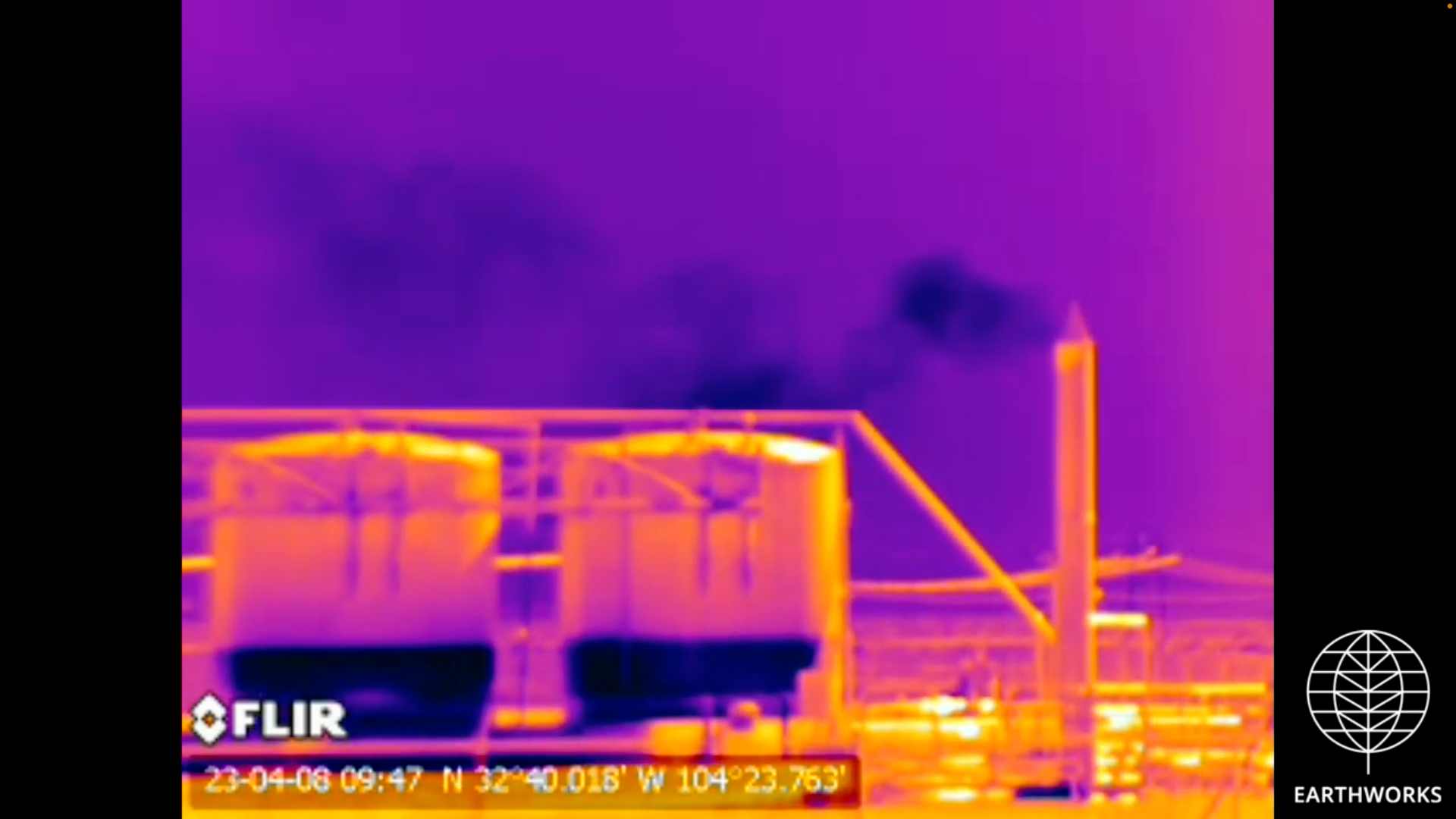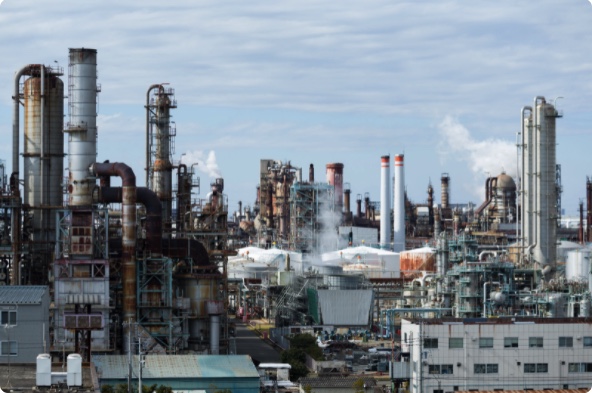
KKR-owned Spur Energy pollutes New Mexico communities
February 15, 2024
“Our communities are heavily influenced by multi-billion dollar corporations and private equity giants such as KKR. It is truly David vs. Goliath when it comes to the work we do.”
– Kayley Shoupe, Carlsbad NM resident and community organizer for Citizens Caring for the Future
The Permian basin is a hot spot for upstream oil and gas exploration. It is the most productive oil basin in the country and is responsible for twice the oil and gas emissions as other basins in the United States, according to a recent study by the Environmental Defense Fund.
Spur Energy is one of many upstream companies with operations in the Permian basin. It was created in 2019 by private equity giant KKR to acquire oil and gas wells in the region.[1] The company’s debut acquisition was of approximately 22,000 net acres of oil and gas fields in Eddy and Lea Counties in New Mexico from Percussion Petroleum.[2] Spur Energy then quickly acquired the New Mexico assets of Concho Resources, adding roughly 100,000 gross acres to its portfolio just four months after its founding.[3] According to Global Energy Monitor, Spur Energy produces 6 million barrels of oil a year (bbl/yr) and over 750 million cubic meters of natural gas a year as outlined in Figure 1.
Figure 1. Spur Energy New Mexico Production
| Oil (million bbl/yr) | Gas (million m3/yr) | |
| Eddy County[4] | 5.3 | 647 |
| Lea County[5] | 0.70 | 111 |
The combined 2023 emissions of Spur Energy’s oil and gas assets in these counties is an estimated 5.2 million metric tons of CO2e.[6] This is equivalent to the emissions from burning 5.8 billion pounds of coal in a year.[7]
Environmental Impacts of Spur Operations
Spur Energy Stonewall 9 Fee #1H Battery. Eddy County, NM. April 8, 2023.
This video of Spur Energy’s Stonewall site (provided by Earthworks) captures an unlit flare with a continuous tail of emissions from the tank battery in April 2023[8]. Flares are designed to burn off methane—a greenhouse gas that is over 80 times more potent than CO2 in its contribution to global warming—and break down volatile organic compounds (VOCs) that return to the surface of an actively producing well. However, this video shows the flare was not lit, which means dangerous pollutants were being emitted into the air. Such VOCs can put nearby communities at serious risk.[9]
This facility sits right off US HWY 285 between Carlsbad and Artesia, New Mexico and is located near homes in an agricultural community. According to an Earthworks thermographer, throughout several field inspections, this flare has been emitting consistently since at least April 2022.[10] Despite a formal complaint filed by Earthworks to the New Mexico Environmental Department (NMED) highlighting these harmful emissions,[11] the flare was still emitting gas as of April 2023. Earthworks has filed complaints on other Spur Energy sites as well.[12]
“Sometimes it’s easy to forget that the failures of energy companies such as Spur have real life and immediate impacts on people and communities. Citizens Caring for the Future is a small grassroots environmental advocacy group in Southeast, New Mexico that works to hold polluters accountable and remind people that we are here, living with negative impacts and having our resources depleted every day. This mission of ours is easier said than done, as we live in the most active oil basin in the country. Our communities are heavily influenced by multi-billion dollar corporations and private equity giants such as KKR. It is truly David vs. Goliath when it comes to the work we do.
“The Permian Basin is likely where the last barrel of oil will ever be pumped, and because of very conservative local politics, a lack of competing industries, and the rural nature of the region many people don’t speak up when it comes to their concerns about health and the environment. This makes owning assets in this region a win-win for private equity. You get a return on investment without local communities making a fuss. This dynamic not only hurts our community, but the ripple effect of the unnoticed emissions that happen everyday in the desert we call home will impact human beings across the world for years to come.”
– Kayley Shoup, Citizens Caring for the Future
Spur Energy has a record of oil spills and flares
According to the New Mexico Oil Conservation Division, Spur Energy operations have flared over 1 million MCF of gas in New Mexico through over a thousand major flaring events since Jan 2022.[13] This is equivalent to the emissions of over 12,000 gasoline-powered passenger vehicles driven for one year.[14] To ensure operators reduce waste, the state in 2021 adopted a new regulation that aimed to nearly eliminate routine natural gas flaring by requiring operators to capture at least 98 percent of gas produced by April 2022. In March 2023, the Oil Conservation Division reportedly has proposed civil penalties for Spur Energy for violating a compliance order for gas flaring or venting. The status of those proposed penalties is unknown at the time of writing.
Aside from flaring, New Mexico Energy, Minerals, and Natural Resources Department data shows that Spur Energy operations were also responsible for at least 31 oil spills, 11 considered major, since Jan 2022.[15] The spills occurred on private, state, and federal land and were either crude oil or produced water spills that totaled 800 barrels of volume released, 99 barrels of which were unrecovered.[16]
The New Mexico State Investment Council (SIC), the Sovereign Wealth fund that manages New Mexico’s permanent funds investments, invested $100 million in KKR Diversified Core Infrastructure Fund in May 2021. In considering the investment with KKR, the SIC’s director of real estate and real assets noted that Spur Energy had nearly 20 oil-spill incidents in 2021, based on a 2021 report by PESP. In response, Ken Melman, KKR global head of public affairs and co-head of KKR global impact, told the investment council that the oil spills were a result of a freeze in the region that resulted in infrastructure equipment failures.
Spur Energy is financially backed by fossil fuel giant KKR
Spur Energy Partners was created by KKR in mid-2019 through a multi-billion-dollar investment from KKR’s Real Assets strategy to acquire large oil and gas development and production assets in the United States. Spur Energy also lists a smaller private equity firm, The Energy & Minerals Group as a financial partner.
KKR, a large private equity firm with around $174 billion in private equity investments, is currently invested in around 300 energy assets in around 30 countries around the world.[17] While KKR claims to prioritize environmental responsibility, as of December 2023, around 62% of its energy portfolio was rooted in fossil fuels. The firm is invested in several high-profile projects responsible for environmental and community harms that have been publicly criticized by community groups and others. These projects include the Coastal GasLink Pipeline being built on unceded Wet’suwet’en land in Canada, the Port Author LNG project in Texas, and the Cameron LNG project in the Cameron Parish in Louisiana.[18]
KKR also received a “D” on the 2022 Private Equity Climate Risks Scorecard due to its high percentage of fossil fuel portfolio companies compared to renewable companies within its energy portfolio, lack of emissions reduction commitments and public disclosure of fossil fuel holdings or emissions, as well as its stated intention to continue to invest in oil and gas as part of its climate strategy.
KKR faces public scrutiny on climate record
Some of the fossil fuel assets KKR has invested in have drawn public outrage from impacted communities and environmental activists.
Since 2018, the Coastal GasLink Pipeline has faced escalating resistance from First Nation’s Hereditary Chiefs and allies, who call themselves Land Defenders. A December 2023 report by Amnesty International detailed “the years-long campaign of violence, harassment, discrimination, and dispossession” against the Land Defenders by the Royal Canadian Mounted Police. The report called for halting construction of the pipeline, ceasing operations, and the withdrawal of the RCMP from Wet’suwet’en territory in Northern British Columbia.
New York’s Museum of Modern Art has also faced escalating protests due to its connection to KKR. Marie-Josee Kravis, wife of KKR co-founder and co-executive chairman Henry Kravis, is the board chair of MoMA. In June 2023 activists disrupted the MOMA’s annual Party in the Garden with signs and banners and fliers with an open letter demanding the museum cut ties with the Kravises. In September, activists returned to MoMA along with members of the Wet’suwet’en First Nation, calling for MoMA to drop Kravis. Extinction Rebellion activist, Laura Esther Wolfson stated that MOMA should “admit the mistake they’ve made and refuse any association with KKR. Marie-Josee Kravis’s presence on the Board is a hideous stain on one of the world’s most significant cultural institutions.” 16 protestors were arrested at the protest.
*This blog includes analysis of a dataset of private equity ownership of energy companies and assets developed jointly by researchers from Americans for Financial Reform Education Fund, Global Energy Monitor, and Private Equity Stakeholder Project.
[1]https://www.businesswire.com/news/home/20190514005284/en/KKR-and-Spur-Energy-Partners-Form-Partnership-to-Pursue-Oil-and-Gas-Opportunities; https://web.archive.org/web/20240123201405/https://www.key.com/businesses-institutions/our-transactions/deals.sep-permian-llc.html
[2]https://www.businesswire.com/news/home/20190514005284/en/KKR-and-Spur-Energy-Partners-Form-Partnership-to-Pursue-Oil-and-Gas-Opportunities
[3] https://www.hartenergy.com/exclusives/spur-energy-strikes-again-925-million-concho-deal-182462
[4] “Eddy County – Spur Oil and Gas Asset (New Mexico, United States).” GEM.wiki. Accessed 1 February 2024. https://www.gem.wiki/Eddy_County_-_Spur_Oil_and_Gas_Asset_(New_Mexico,_United_States)
[5] “Lea County – Spur Oil and Gas Asset (New Mexico, United States).” GEM.wiki. Accessed 1 February 2024. https://www.gem.wiki/Lea_County_-_Spur_Oil_and_Gas_Asset_(New_Mexico,_United_States)
[6] The upstream emissions were calculated utilizing RMI’s OCI+ database on oil and gas supply chain emissions. Upstream and embedded fuel emissions factors by basin were utilized. Rocky Mountain Institute. “Oil Climate Index Plus Gas.” Last updated April 2023. Accessed November 2023. Available at: https://ociplus.rmi.org/
[7]https://www.epa.gov/energy/greenhouse-gas-equivalencies-calculator#results
[8] Optical gas imaging video by Earthworks ITC certified thermographer using FLIR GF320 camera. Learn more about Earthworks field investigations here: https://earthworks.org/campaigns/field-investigations/
[9] Holder, Chris et al. “Evaluating potential human health risks from modeled inhalation exposures to volatile organic compounds emitted from oil and gas operations”. Journal of Air & Waste Management Association. Published November 7, 2019. https://www.tandfonline.com/doi/full/10.1080/10962247.2019.1680459
[10] Stonewall 9 Fee #1H Battery video Oct 2022, Nov 2022.
[11] Spur- Stonewall 9 Fee #1 H Battery/ Complaint #16824 submitted 04/18/2023
[12] Spur- VT 36 State #1H Battery/ Complaint #17291 submitted 10/02/2023; Spur- White Oak State B Battery/ Complaint #17309 submitted 10/03/2023
[13] New Mexico Energy, Minerals and Natural Resources Department. Oil Conservation Division. Incident Search database. Accessed December 14, 2023. https://wwwapps.emnrd.nm.gov/OCD/OCDPermitting/Data/Incidents/Incidents.aspx
[14] https://www.epa.gov/energy/greenhouse-gas-equivalencies-calculator#results
[15] New Mexico Energy, Minerals and Natural Resources Department. Oil Conservation Division. Incident Search database. Accessed December 14, 2023.
[16] ibid
[17] PECR research
